The Electronically Cranked Coil Tester
Model T owners have often come up against
the difficulty of correctly testing and adjusting their ignition coils.
A fortunate few own a hand cranked tester of the kind illustrated in the
Model T Ford Service Manual. Others try and get by with simple buzz box
testers. There are even some who use completely non electronic methods,
such as measuring spring tension, or listening for a certain "musical note"
as the coils buzz. To any technically competent person, these latter two
methods are extremely crude, and they cannot give known or repeatable results.
Hand cranked coil testers (HCCT) are few
and far between, and when they do turn up are extremely expensive - hence
the crude methods used instead. However, there is still a limitation with
the HCCT, in that there is no way of setting the coil's firing time so
it is the same as all the others.
Electronic Coil Testing.
At this point I recommend reading the
article
here if you have not already done so. It goes into further detail on
why setting coils for equal firing time is important, and describes an
electronic tester that performs this function. While the tester so described
works very well, it requires an oscilloscope, and the ability to interpret
its display. Thus, it is only suitable for the Model T owner with an electronics
background.
The good news is there is now a test instrument
that anyone can use, the ECCT. It works on the same principles as my CRO
based tester, but it has been carefully designed so that any Model T owner
can use it. I have no affiliation with the design or manufacture of this
instrument, but I have had the opportunity to try one out.
It immediately became very clear that
the ECCT fulfills the need for an instrument that anyone can use, regardless
of technical ability. It is not only very inexpensive compared to a HCCT
(if you can get one!), but allows for the coils to be set for the all important
equal firing time. Additionally, facilities to test the coil capacitor
are provided, and for those with a working magneto, the instrument can
test this also.
What is the ECCT?
The "Electronically Cranked Coil Tester"
is a very compact unit, hardly bigger than the coil itself. The unit is
made using printed circuit boards for its enclosure and has a very simple,
yet elegant look. It runs from an external 12V 8A switchmode power supply,
which has the usual 100-240VAC input via an IEC socket. Thus, it is a simple
matter to substitute a local power cable wherever you might be in the world.
Provided care is taken with polarity, it can also be used with a 12V battery,
giving complete portability.
On the front panel is a LED display and
testing switches.
The coil to be tested is simply inserted
and then the relevant buttons pressed to perform the required test.
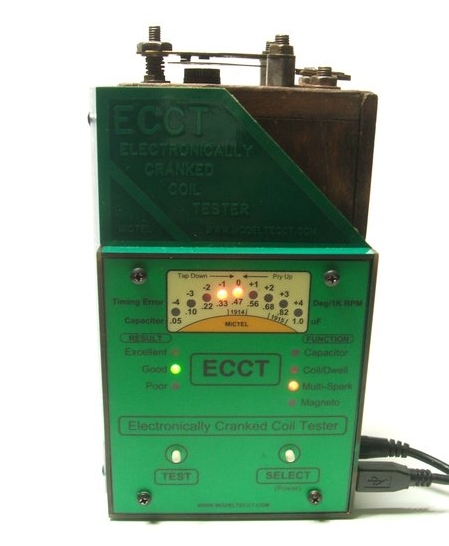
In its basic form, the instrument will
perform coil and capacitor tests, with the LED's displaying the results.
The "Excellent", "Good", and "Poor" indicators mean that no technical interpretation
is required. When setting the vibrator spring tension, one simply observes
the timing error LED's and reduces or increases the tension for a zero
degree timing error.
It really is that easy to use. However,
don't be deceived by the simplicity, because internally, it is a very accurate
instrument. It is this simplicity plus accuracy aspect that makes it the
perfect coil tester for everyone.
Computer Interface.
Of course, Model T owners who have a technical
understanding of the ignition system will be keen to see more than a LED
display. In view of this, a USB port is provided for interface to a computer.
This opens up a whole new world because results are now displayed graphically,
and numerically.
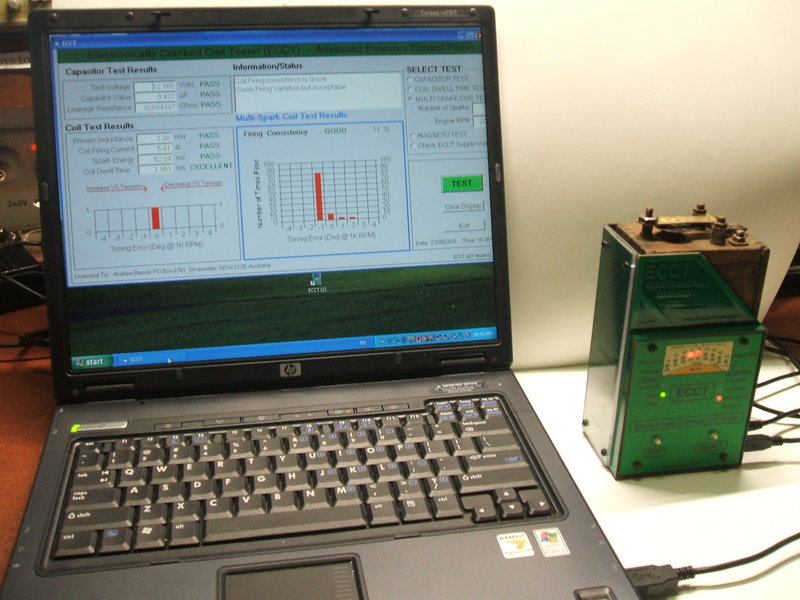
It must be pointed out that the computer
interface is an option, and for the non technical user who wants to keep
the cost down, it is not actually required. The simple front panel LED
display will allow coils to be adjusted just as effectively.
Trying out the ECCT.
The earliest computer I have with USB
support has Windows 2000. The ECCT software functioned perfectly on this,
as well as other machines with XP and Windows 7. What I did find was that
a minimum screen resolution of 1280 x 1024 is needed, otherwise the right
hand side of the software window is cropped. This does not impede functionality,
however. I found the ECCT to be intuitive right from the start, probably
because of my experience with this method of coil adjustment. Nevertheless,
the supplied instructions are very well written in a step by step format.
Directions are given on how to correct the coil settings if they are not
as they should be. Now, let's look at the tests the ECCT can perform:
Capacitance.
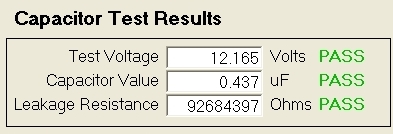
This is the first test that should be performed,
because if the capacitor is excessively leaky, firing performance may be
reduced regardless of how well the points are set. Capacitors can also
fail short circuit or open circuit, and no amount of point adjustment will
give a proper spark.
Here, the capacitor measures over 92M
which is an extremely low leakage. This is to be expected if there is a
new capacitor installed. Old leaky paper capacitors may indicate 100K ohms
or less. The test fails with under 10M leakage. That is not to infer a
coil with, say 2M leakage, is defective and won't perform adequately, but
it indicates something is not as good as it could be. Typically, this would
be because the original capacitor is still in place, and/or the coil box
wood has been painted with something conductive. My recommendation is to
routinely replace original coil capacitors, because it eliminates future
problems, ensuring the spark is always as strong as it can be. Modern plastic
capacitors do not deteriorate, so once installed they will last a lifetime.
Of course, the correct capacitors must be used or short life will result.
See here for
further details.
Coil & Dwell.
Having ensured the capacitor is satisfactory,
the next test to perform is the coil firing time (dwell). What is dwell
you might ask? In an inductive circuit, such as a Ford coil (or even a
modern ignition coil), when current is applied it takes a certain amount
of time for the iron core to fully build up its magnetic field. When fully
built up, it is "saturated" and continuing to apply current has no further
effect. Most efficient coil performance will occur when the coil fires
just as the saturation point is reached. Here, the magnetic field is strongest
without wasting power. Any further application of current is simply wasted
as heat. With a Ford coil, the ideal dwell time happens to be 3.5ms if
the supply is 6V, and 2ms if it is 12V. With magneto operation, the dwell
time varies with the change in voltage. The important thing is that each
coil has the same dwell time to ensure that no cylinder fires advanced
or retarded relative to the others. This is the basis of ECCT testing.
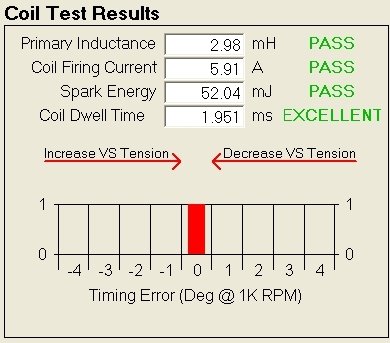
As can be seen, the primary coil inductance
is measured, as is the peak firing current. This is the current right at
the firing time, and is not to be confused with the lower, average, current
often quoted for coil adjustment (1.3A at 6V). From this, the ECCT microprocessor
calculates the actual spark energy.
The all important coil dwell time is measured
to an accuracy of three decimal places. While such accuracy is not actually
necessary, it does show the instrument can actually measure it. With the
coil test voltage performed at 12V, the ideal firing time has been determined
to be 2ms, so this corresponds to a zero degree timing error.
This corresponds to 3.5ms on my own CRO
based tester, when the test is performed at 6V. While it is perfectly satisfactory
to set firing time at 6V, it is really necessary to use 12V to check for
multiple sparking, as this does not always show up on the lower voltage.
My own tester can do this, and the ECCT does so by default.
While the dwell test is being performed,
any signs of multiple sparking are detected. This results in a message
to adjust the upper cushion spring tension.
Multi-Spark test.
In this test, the coil is fired at up
to 100 times with and equivalent engine speed of up to 2000rpm. These parameters
are user selectable.
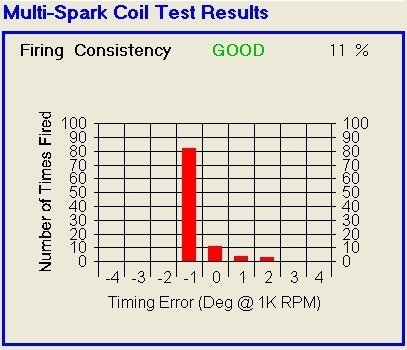
The purpose is to examine the firing consistency.
While one single fire may appear to show a good result, is this always
consistent? Any deficiency with the coil points will show up when rapidly
fired, like they would be in a car at normal engine speeds. Problems like
contact bounce and dirty contacts will show up here.
Magneto test.
This is an additional option. Given that
not all Model T's have a working magneto, further cost saving is possible
by not opting in for this feature.
Magneto voltage is measured along with
engine rpm.
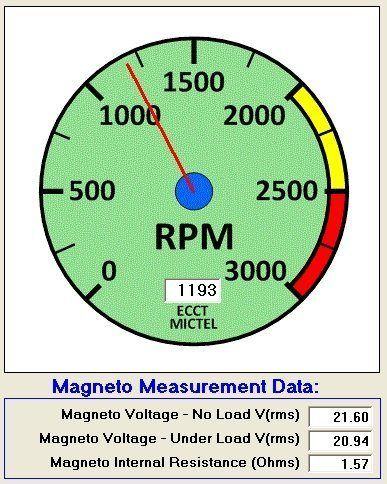
Load testing is performed by a simulated
St. Louis Magneto Tester, an original design from the T era, renowned for
its ability to test a magneto’s power output regardless of engine speed.
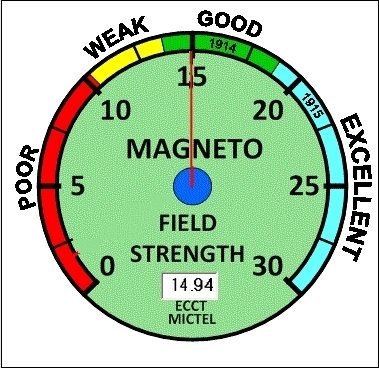
Testing The ECCT.
With all features enabled in the ECCT
I was testing, it was an ideal opportunity to do some detailed tests and
compare with my own electronic tester. As my tester had been developed
completely independently, it was fascinating to see how it compared, and
to confirm the legitimacy of the testing method.
Capacitance tests.
As expected, capacitor values tested within
tolerance, when compared to measurements taken from an Escort ELC-131D
hand held LCR meter. It was noted that accuracy decreased with an increase
of capacitor leakage. However, this in itself was not a limitation because
capacitors with high leakage should be replaced anyway.
One thing that did cause confusion was
that the capacitor test would fail, with a reading of 0uF with some original
paper capacitors. This was found to be because of a small voltage being
generated from within the capacitor, most likely due to electrolytic action
occurring because of moisture. I measured up to 320mV into a 10M DVM with
the set of original coils I used for the test. Again, such readings indicate
the capacitor should be replaced.
It was found also that incorrect results
would be given when the coil points mounting nuts were touched during the
test. Evidently, there was enough 50c/s radiation from the power mains
being picked up (1.2V p-p into 1M) to upset the testing. This was confirmed
when the ECCT was operated from a battery away from the power mains. Here
it worked normally even if the nuts were touched. The capacitance
test calls for holding down the vibrator spring so that the capacitor is
not being short circuited. However, if the vibrator spring touches the
coil core underneath, then leakage to this point is measured as well, giving
a not entirely true capacitance leakage result.
Ultimately, the most accurate way to measure
the capacitor is by inserting a piece of plastic between the contact points
and not touching any part of the coil during the test.
Coil firing time.
This test actually showed up some inaccuracies
with my own tester. While the results were sometimes identical, at other
times they were not. It became clear that using a low cost CRO was one
limitation. For one thing, the timebase calibration was found to have drifted,
and was not completely linear. There was also the possibility of Parallax
error because of the graticule's distance from the phosphor screen of the
CRT. These problems have since been eliminated since I performed the tests
by changing to a decent CRO; a Tektronix TAS475.
Once that was cleared up, the ECCT was
found to be completely accurate with regards to the coil firing time. It
also was found to reliably detect multiple sparking. If it showed up on
the CRO, then the ECCT also detected it, and vice versa. From this test
alone, it is clear that the ECCT can substitute for mechanical testers
such as the HCCT.
As was expected, it was found that firing
current varies slightly amongst individual coils, even though the firing
time is identical. This is a trap for those who have always set by current
on other kinds of tester. The golden rule is to set for equal firing time,
not
equal current.
Coil Firing Consistency.
My CRO based tester does not have the
ability to log firing consistency, but one can subjectively get an idea
of how good or bad this is by listening to and observing the coil sparking.
The ECCT can log this over a period of up to 100 sparks. I found with coils
which had a less than perfect firing consistency, on the CRO based tester,
that the ECCT would detect this also, and vice versa.
Magneto Tests.
This was something I could not test in
a real world situation because I do not have a magneto in my Model T. However,
using a BWD Mini Lab 604 function generator, I was able to determine that
the tachometer and magneto voltmeter were accurate. The latter is actually
a true rms voltmeter, and gave consistent readings regardless of input
waveform. I used sine, triangle, and square wave inputs for the test.
The tachometer readings were calculated
from the input frequency, and again were found to be accurate.
A challenge was simulating the magneto
field strength test. I largely overcame this by using an audio power amplifier
in between the function generator and the ECCT.
This was necessary to get the low output
impedance and voltage swing to simulate a real magneto. It was found that
the pass/fail for the internal resistance test was 3 ohms. A high resistance
reading alerts the user to a fault such as a magneto post with poor contact.
While I couldn't actually do the field
strength test and compare the reading against anything, it certainly appeared
to function as it should.
Overall Impressions of the ECCT.
As the designer of the CRO based tester,
I related to the ECCT straight away, and understood the results with no
further interpretation required. This is because the coil testing feature
of the ECCT works on the same principle of measuring dwell.
A welcome option would be to include a
dwell time (ms) calibration for the graphical and LED display. However,
it is understood the ECCT is designed for a market more familiar with mechanical
engineering, hence the preference for displaying degrees. This is a very
minor point, because anyone who wants a millisecond reading would most
likely be using the software, which does display this.
Using the ECCT showed it was much more
than just a coil tester. It is in fact a comprehensive Model T ignition
system analyser, suitable for coils used either on battery or magneto.
It is hard to imagine a more compact,
attractive, and user friendly design with the simple, yet effective and
rugged method of construction used.
I found the instructions to be well written,
in logical order, and in terminology anyone can understand. How to interpret
the results and take corrective action is made particularly clear.
Versatility is also a welcome part of
the ECCT which should appeal to prospective purchasers. The user is not
obliged to purchase the software interface, if this is seen as too technical.
The essential results are visible on the basic tester, and are just as
accurate. Likewise, those without magnetos do not need to purchase the
magneto testing option.
Naturally, all the extra features which
the ECCT has are interesting in themselves. If you have an interest in
the Model T ignition system you will find it addictive, wanting to spend
hours with the ECCT learning all about coil adjustments and characteristics.
In fact, I was so impressed with the ECCT
that I bought one!
In terms of my own personal use, I use
the ECCT in conjunction with my CRO based tester. The CRO based tester
is good for the initial coil test because it allows quick real time adjustment.
Then the ECCT is used for the final firing time accuracy, and to look at
the other coil characteristics. To provide a CRO interface on the ECCT
can be done during manufacture, but it would be lost on most users. However,
once I did purchase my own ECCT, I did fit it with connections to trigger
a CRO, and provide a current waveform. Now, I have the perfect coil tester
- a visual current waveform of the coil firing and the superior
accuracy that the ECCT offers.
Why the Model T owner will benefit
from the ECCT.
It should be clear by now that there is
a lot more to the Model T ignition system than simply making the coils
produce a spark. A car with an ignition system set up that way will actually
run, but the full potential of its performance will be impossible to achieve.
These are the cars that struggle to get up to 60km/h and run rough.
Improperly set coils may suffer from:
-
Insufficient current leading to a weak spark,
especially with 6V or with low engine revs on magneto.
-
Too much current leading to overheating coils
and burned points.
-
Uneven dwell time, leading to cylinders firing
retarded or advanced relative to the others in the set.
-
Multiple sparking which causes a loss of sparking
power on the initial fire, and being voltage dependent, causes rough running
on magneto.
Buzz box testers can test for the first two
characteristics only. While in theory, their meter could show the dwell
time, this would only happen if the meter: 1) had sufficient accuracy,
and 2) all coils had identical characteristics. The reality is there is
a variation between individual coils and dwell time vs. current.
The HCCT is a vast improvement in that
it can test for multiple sparking as well as coil current. Again, because
of the simple analog meter and differing coil characteristics, it still
cannot test dwell time.
For this reason, the Model T owner who
wants optimum ignition performance will benefit from the ECCT. It performs
all these tests.
Clearly, electronic testing, such as that
provided by the ECCT, is the future of Model T Ford coil testing. All aspects
of coil operation, invisible on other testers, can now be displayed, and
corrected where necessary.
The ECCT
site is here. More information is available there on how the ECCT was
developed, and you can also get a feel for the instrument by downloading
the instructions.
I really do urge all Model T owners using
the original ignition system to think about this, because properly adjusted
coils and a good timer will give performance as good as a distributor system.
Home








